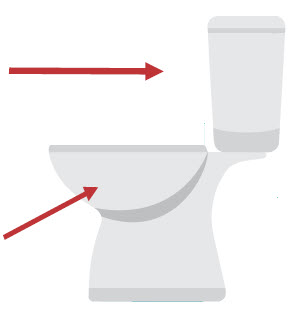Sanitation
RVEM
In a disaster, plumbing may not be usable due to disrupted water and sewer lines. Each person in your household should know how to properly dispose of human waste (i.e. a two-bucket system - see below) and sanitize all necessary items in order to avoid infection and spread of disease.
TIP: If th e water is off but the sewer lines are unaffected, toilets can be flushed with stored water. Save your drinking water and opt for dirty water to flush!
e water is off but the sewer lines are unaffected, toilets can be flushed with stored water. Save your drinking water and opt for dirty water to flush!
- Pour water in holding tank to flush. This method requires more water since the tank must be full to flush.
- Throw water with force in bowl to flush. This method works by force and requires less water.
Emergency Supplies Recommended
- Two five-gallon plastic buckets with tight fitting lids or five-gallon metal containers with tight fitting lids should be stored as makeshift toilets. A seat can be fashioned from a pool noodle cut length wise and placed on the rim of the bucket, or a toilet seat for a bucket can be purchased. Portable toilets can be obtained from a camping supply store.
- Keep a supply of plastic liners (5-6 gallon size) to line your buckets.
- Store toilet paper, disinfectant spray, hand sanitizer, deodorizer tablets and air fresheners nearby.
- One or more large metal covered garbage cans should be available to contain waste after it has been sealed in plastic. If you don’t have large cans available consider storing several five-gallon buckets for disposal.
Four Types of Surface Disinfectants
- If water is available, it is best to use a solution of one part liquid chlorine bleach to ten parts water. (Don’t use dry bleach, which is caustic and not safe for this type of use.)
- HTH, or calcium hypochlorite, (Chlorine), is available at swimming pool supply stores. HTH is intended to be used as a solution with water. It can be mixed according to the package directions and then stored.
- Portable toilet chemicals, both liquid and dry, are available at recreational vehicle supply stores. These chemicals are for use with toilets that are not connected to sewer lines. Use as directed.
- Powdered, chlorinated lime is available at building supply stores, which can be used dry. Be sure to get chlorinated lime and not quick lime, which is highly alkaline and corrosive.
Disinfecting Surfaces With Bleach
- First, wash surfaces with soap and warm, clean water to remove dirt and debris, if possible.
- Next, sanitize surfaces with diluted regular, unscented household bleach that is dye free.
- Never mix bleach with ammonia or any other cleaner.
- Wear rubber or other non-porous boots, gloves and eye protection.
- Try not to breathe in product fumes. If using indoors, open windows and doors to allow fresh air to enter.
- Check the CDC website for recommendations for cleaning and sanitizing food cans and surfaces. Water-to-bleach ratios will be different for different surfaces and applications. Print materials and charts for each and store them in your emergency kit - you may not have access to the internet after a large event.
TIP: If you elect to build a latrine, be sure you know the necessary distance between the pit and any nearby water sources and the distance above the groundwater table. The hole should be 2 % feet deep, 1 foot wide and 4 feet long. Soil removed from the trench should be placed nearby to shovel after each use. Cover the trench completely when the waste and soil reach within a foot of the top.